ALLIGATOR
BEHAVIOR page 2d: SOCIAL SIGNALS AND BELLOWING 4 1 2 3 5 6 7 8 9 10
This
page was born 07/04/2008. Rickubis designed it. (such as
it
is.) Last update: 11/26/2012:
Images
and contents on this page copyright © 2001 - 2012 Richard M.
Dashnau
Alligators,
although they are ectothermic and also equipped with a small
brain, exhibit
a surprising diversity in their responses to their environment
and to each
other. They are for more
complex than mere animated logs or 12-foot-long
eating machines. This group of pages show some
of what I've been able to
see in the years I've been volunteering (September of 2001
thru March of 2020) at Brazos Bend State
Park.
May 18,
2003
This morning, not long after I'd started walking near Elm Lake, I
heard
an alligator head slap near pier 2. As I started hurrying
towards
the sound, I began hearing bellowing. When I got
close to the source of
the bellowing, (it sounded like 2 females and one male) I noticed
a large
male alligator swimming parallel to my course, That is, he was
headed towards
the bellowing. I could just
make out the male that had been bellowing,
when the larger one got close to it. The bellowing male was at
least half
a length shorter than this male that followed me. The smaller
alligator
beat a hasty
retreat to the center of the channel...but only about 25 feet
or so away. The larger alligator showed a puffed-body/tail-arch
posture
for a while, then got closer to the far shore and began bellowing
(see
MY YARD, below or video
clip
(1,452 kb)). When the large male bellowed, I'm sure I felt a
subtle vibration;
similar to what one feels sitting next to a large, low frequency
speaker.
As I looked at my video,
it seemed to me that there is a slight vibration
of the camera near the "waterdance" stage of the bellow cycle.
---- ---
---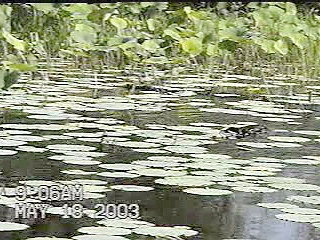 ---
---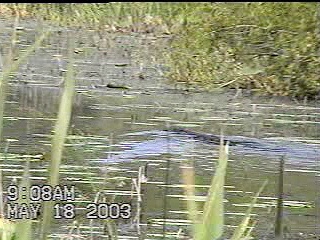 -
-
MY YARD!
I SAID, MY
YARD!
THERE THEY GO
The
large male continued bellowing, and what sounded like two females
(on either
side of the large male) began bellowing as well. This went on for
about
3 bouts. After the bellowing stopped, two
smaller alligators (about 6 or
7 feet long) appeared from the East, swimming alongside each
other.
The large male turned, and swam out to meet them. The smaller one
of the
two stopped swimming
immediately. However, the other one didn't, although
it *did* try to swim around the big male. It was able to move
around the
large one, but the male continued advancing, and then turned to
follow
the
small alligator (see I SAID, above or video
clip (1,424kb)). And then the chase was on! (see THERE THEY
GO, above
or video clip
(678 kb))
This
chase, however, continued down Elm Lake for quite a
distance; maybe 3 or
4 piers. Far enough to require binoculars to see them in the
distance.
That was a nice start to the day.
April
01, 2006 Earth Day Celebration at BBSP. I led a "gator hike"
at Elm
Lake. We saw some great alligator behavior, and a territorial
dispute.
Text below added 4/20/2006.
One
of the reasons that I was so excited about seeing this social
interaction
(besides the fact that it happened in front of me) was that I had,
not
10 minutes before, been lecturing to the hikers about
various types of
alligator social signals. Usually, when I lead the hike, I
will stop
near
an alligator and-whether it's doing anything or not-I will lecture
and
demonstrate some aspect of alligator behavior.
Sometimes, while I'm
lecturing
(interpreting), the alligator will do something, and if I haven't
covered
what the alligator is presently doing, I will try to put what
it *is*
doing into some behavioural context.
By the
way, this particular competition was probably driven by
two factors.
First, this is mating season, and alligators are territorial.
Second,
the water in the lakes in the park is VERY low. This means
less area covered
by water, and therefore a lot less available
territory.
In this
situation, I had just explained how alligators will often indicate
social
status by body position relative to the surface of the water.
The
nose slightly elevated (just the edge of the lips visible)
is
non-aggressive.
Head flat with snout at water surface, is watchful. Submerging
the
head while holding it flat in the presence of another alligator is
submissive.
Back high in the water is dominant.
Head with nose pointing
up sharply
can mean headslap or bellow--both highly dominant signals with the
back
submerged and the tail arched. Tail arched (center of
tail
elevated higher than the
base and tip) can mean readiness to defend or
what I consider a "query" regarding direction an interchange will
take.
These are all positions that the alligator will sometimes take
while feeding,
but then the body positions are in a different context. With
no
other
alligators around these are not signals. All these images are from
the
short video clip I shot. The video clip can be seen here
(mp4)
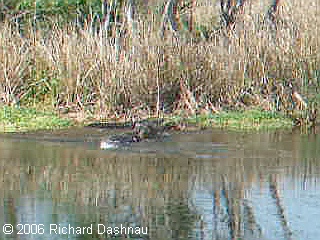 -
-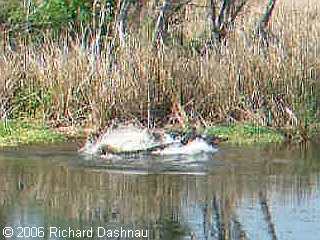 -
-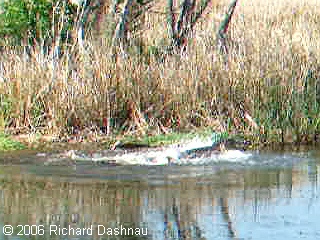 -
-
AFTER THE FIRST LUNGE
SUBMISSIVE
TRAPPED
AGGRESSOR PASSES
SUB
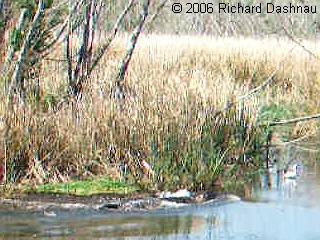
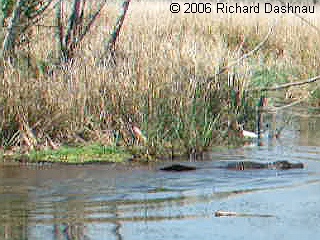
SUBMISSIVE STOPS
AGGRESSOR IN FRONT
The
headslap is an action where the alligator lifts its head, then
suddenly
drops lower jaw under the surface of the water, then slams upper
jaw
down
to meet the lower jaw; resulting in a loud
pop/slap sound--which is sometimes
accompanied by a short growl as the upper jaw is brought down.
I've seen this often immediately after a direct alligator
challenge. I've
seen either the
apparent winner or "loser" of the exchange (I assume
the
one that submits is the loser) do a headslap. Generally if the
dominant
"winner" does it, the headslap is within view and within chase
distance
of the "loser". Most alligator interaction is non-violent, and
involves
a lot of submission and swimming away.
(examples
of many of these behaviors can be seen on my other pages,
such as the "alligator
social signals" pages:
social
signals
01 social
signals
02 social
signals
03
I learned
a lot of this by watching the alligators use these signals and
others in
context over the last 4 years. An early source for comparision
was
a study available from the American Museum
of Natural history, titled--"Social
Signals of Adult American Alligators", by Leslie Garrick,
Jeffrey
Lang, and Harold Herzog (Bulletin of the American Museum of
Natural History
Vol. 160:
Article 3; pages 157-192, 1978; click here
to see the AMNH digital library and get the pdf.) This is a
very small
publication,
like a small magazine in format, but it is a detailed study
of alligator
communication among animals observed in Florida.
Another
source for descriptions of alligator social signals is:
Crocodilian Biology
and Evolution, Gordon C. Grigg, ed. Feb, 2001.
(pp. 383-408)
There
is also some reference in this book to the earlier work.
--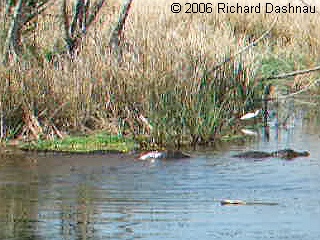 -
-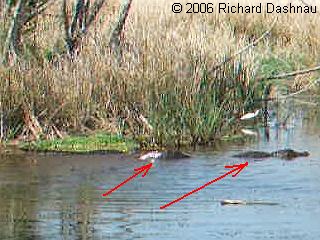 -
-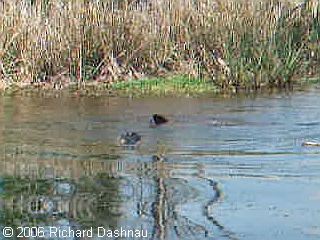 -
-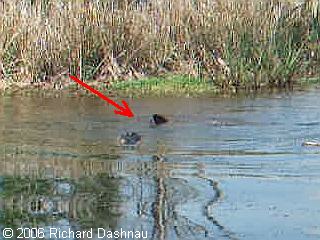
AGGRESSOR THRASHES TAIL SLOWLY
TAIL ARCH
WITH
HIGH
BACK
SUBMISSIVE
SUBMERGED
TAIL
ARCH
I'd
talked about what I called the "panic dive". Although alligators
can hold
their breath for a long time (I've read between 1 and 4 hours),
they
cannot
do this every time they submerge. If an
alligator is surprised or
under duress, it performs a "panic dive". In this circumstance,
the
alligator
can only hold its breath for a short time, and generally
resurfaces quickly
to assess the situation
that made it dive in the first place.
I have
often seen this in practice.
In the
book Crocodiles:Inside Out, by K.C. Richardson, G.J. Webb
and S.C.
Manolis, there is a concise description of the circulatory changes
that
happen during what they term a "voluntary"
dive on pages 81-82. According
to the descriptions and the simplified drawings with them,
crocodilians
have two major connections in their circulatory systems which
allow deoxygenated
blood to mix with oxygenated blood.
Remember--mammals
have a 4-chambered heart, which keeps blood rich in oxygen
seperated from
deoxygenated blood, which allows
for
more efficient
oxygen supply to the body and therefore more efficient metabolism.
Most reptiles have a 3 chambered heart, generally
less
efficient because oxgenated and deoxygenated blood can mix
together within
the heart; resulting in overall less oxygen being available to
body tissues.
Alligators, however, have a four-chambered heart! However, there
are to major connections in the
alligator's circulatory system that
allow
for mixing of O2+ (oxygenated) and O2- (deoxygenated) blood.
While
this would seem to lessen efficiency--in fact might seem to be
defects --these
are
part of a complex mechanism which allows crocodilians to remain
under
water for such long periods of time. As time passes while the
crocodilian
is submerged, it can restrict the blood flow to its
lungs (which aren't
used then), skin, and other low-priority organs while
simultaneously increasing
flow
to such high-priority organs as brain and heart; and it also deal
with lactic acid buildup. When
the crocodilian finally does surface
after
such a long period, it breathes normally; without stress incurred
from
its long period without air.
At the
end of this description is a paragraph that states
that during and "involuntary"
or "fright" dive (which I called the "panic" dive")
the
crocodilian can only stay under for a short time. After
this, it
will resurface, breathe normally, and can then perform
a "voluntary" dive
and
remain
submerged for a much longer period of time.
Finally,
I talked about a concept I call "escape in 3 dimensions". This is
a concept
I came up with myself, and I've
been looking for various
examples.
Generally, I consider this a technique that is useful at the
boundary between
two environmental media. Examples are the boundary
between
air and water,
air and ground, or ground and water. In the case of alligators,
I've seen this during social interaction. As I understand
it,
most alligator communication requires water for transmission. A
lot of
information is conveyed by alligator body position relative to
water
surface.
Water is also used for head slapping, bellowing (the
low-frequency
vibration--"water dance" over the back), tail
swishing, and
snout-bubbling
(expelling air from nostrils or mouth to make bubbles).
Alligators
will occassionally interact on land, but such interactions often begin
and/or end in the water.
Alligator
chasing usually happens at the water's surface. The pursued and
pursuer
can move towards or away from each other. In all-out pursuit,
speed
can increase until both alligators seem
like motorboats. Sometimes, a pursued
alligator will raise its tail and thrash it enough to cause
turbulance
and splashing, then turn 90 degrees to the right or left.
Sometimes this
ploy works...
briefly. The turbulance can disrupt the pursuer's
visual
and possible tactile sense (perhaps via ISOs) temporarily while
the pursued
alligator changes direction.
All
of this is what I call "two dimensional" movement. The alligators
are moving
right, left, backwards, forwards--but all in one plane and still
at the
surface of the water. But, if the alligator can't
escape, it may
try in a *third* dimension---down, or up. The alligator may do the
turbulance
trick
and submerge. When it submerges, it may do the 90 degree turn, or
it may
not. But, this is
usually a panic dive, and the alligator usually
can't
stay submerged for long. When it resurfaces, the pursuer can
locate it
and continue the chase.
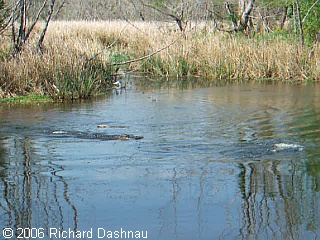 -
-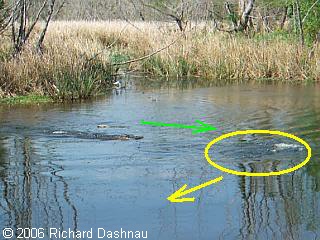 -
-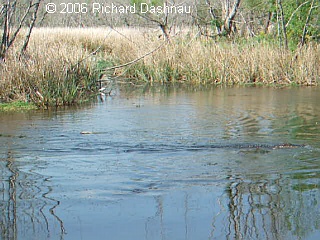 -
-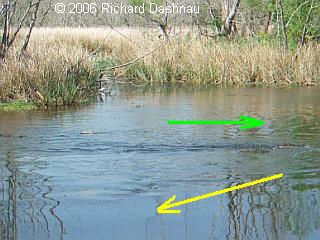
SHORT, STRAIGHT CHASE
WHILE SUB DOVE
AND TURNED
AGGRESSOR CONTINUED...
...WHILE SUB SWAM UNDER
If it
submerges, turns sharply, and swims below and at an angle-which
allows
its pursuer to pass it-it may be out of visual range of the
pursuer
when
it resurfaces. The alligator may also go
"up" by leaving the water and
walking onto land. This ploy may work not because it becomes
invisible
to
the
pursuing alligator, but because alligators are less comfortable on
land
and the
pursuer may not want to follow. The story I have on another
page
about the alligator with a mouthful of nutria being chased by
another alligator
trying to steal it (and eventually others trying to
take it) illustrates
some
of these movements. That alligator chase also shows a number of
social
signals, my "escape in three dimensions--both onto land and under
water",
and
panic dives. You can see it on this
page.
Before
I shot this video, this aggressor ("dominant") had been
cruising
the water nearly an equal distance from both banks. My hiking
group and
I
followed
the patrolling alligator past 3 or 4
piers. One smaller alligator
moved ahead of it, and eventually cruised to the far bank and kept
a low
profile.
One alligator already at the bank slowly submerged as the
aggressor passed
by.
Finally,
the aggressor moved towards a 7-foot alligator that was resting
with the
front half of its body out of the water. The dominant
slowed,
and
inched towards the beached alligator until
it must have been floating over
the tail. Suddenly, there was a flurry of motion as the
beached
alligator
(which might have suddenly come awake) seemed to realize that the
aggressor
was
so close and lunged onto the bank. The aggressor
moved
towards it again, and that's where the clip starts. If you watch
the video
clip from 04/01/06, you'll see the aggressor's side-to-side
tail
swish, indicating annoyance. The aggressor has his back high in
the water,
then turns back towards the alligator which had run onto the
bank attempting
to
escape (it also didn't have
much choice, since the aggressor was already
on top of it when it was noticed). There's a sharp jump-turn
into the water, and a panic dive. The submissive ("sub") surfaced
off to
my right
(you an only see tail turbulance), which signalled its location
to the aggressor, which chased it. The sub turned 90 degrees
again
(to my left), and did a shallow dive. Its escape route brought
it right
to the
bank in front of us. With a crowd of 20+ humans on the trail
above, I didn't
think it would retreat onto land, but I warned everyone to
stand
back anyway.
Here
the submissive remained, waiting for the aggressor's next move.
When the
aggressor lunged forward again, the submissive did another panic
dive,
and went off to my right, bringing it
behind the aggressor, and some distance
away. *I* was confused, since I had been watching the
aggressor's
position relative to my group of visitors and was assessing this
situation
instead of just watching the alligators.
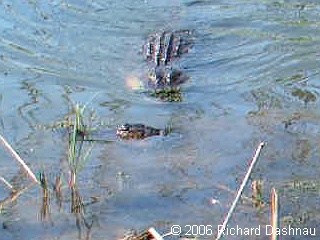 -
-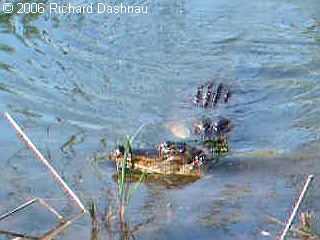 -
-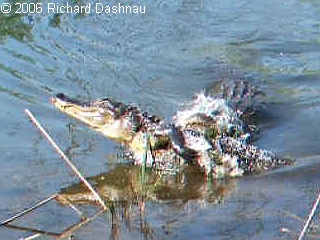 -
-
SUB TRAPPED AGAIN
SUBMISSIVE ESCAPES...
...GOING
UP, AND THEN...
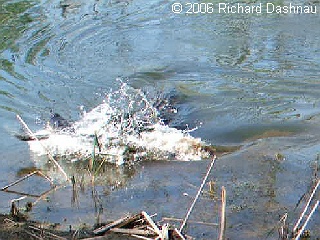
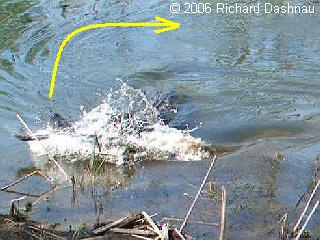
...GOING
UNDER AND TURNING
SUB ANGLES BEHIND
Meanwhile,
the aggressor--who had lost his quarry but didn't know it
yet--stood
with it's arched tail switching side-to-side, its back very high,
and
its mouth gaping open. I've seen the alligator gape as a
threat display--but
open mouth by itself isn't necessarily a threat. It depends on
the
context. An alligator sunning on a bank for a long time will
sometimes
open its mouth as a heat-regulation reflex. There's no tail
thrashing,
body
movement,
etc. In this case the gape was obviously meant to
intimidate.
It worked on us, that's for sure!
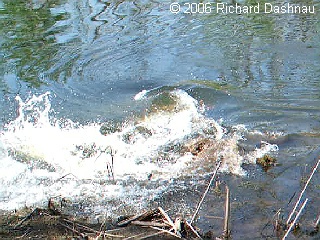 -
-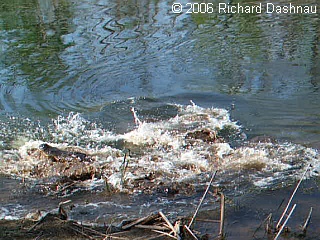 -
-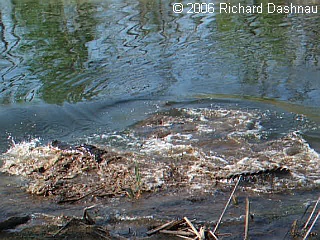
SUB
SWIMS OFF WHILE...
...CONFUSED BY TURBULANCE...
...AGGRESSOR SURFACES...
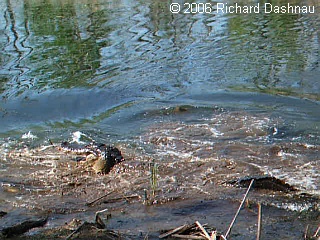
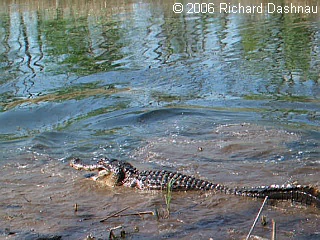
...WITH MOUTH AGAPE...
...BACK HIGH AND TAIL THRASHING
When
the water stopped moving around, the aggressor could see another
alligator
in front of it. It went towards it, but that one wasn't
the
alligator that had made the aggressor so angry,
and after a brief close
inspection, it left it alone (this is also interesting since it
showed
that the aggressor wasn't attacking every other alligator,
and could
therefore tell them apart.)
Finally, after having driven
off
the other alligator, the aggessor moved a little further off (to
the next
pier), and did a head slap. This was reported to me later by a
number of people who
witnessed it.
This
"escape in three dimensions" or "escape across a media boundary"
is an
exciting concept for me. I've seen some birds do something
similar.
A Coot
and a
Moorhen might get into an argument and start swimming after each
other (left, right, forward, backward--one plane--2 dimensions).
At a
certain point, the target may start "fly-running"
over the surface of the
water, or just take off, or submerge (movement up or down, escape in another
plane--3 dimensions). A squirrel will run here and there
(one plane)
if there is no
tree, but once a tree appears, UP it goes. Rabbits
may go down,
if there
is a burrow. One example that got me onto this line of
thinking was
the basilisk lizard. It can run well on land,
but if pursued near
a body
of water, it can run across the surface for a while, before
submerging
and swimming away. What the lizard is actually doing is striking
the
water
with
outsplayed fringed toes hard enough to make a big "hole" in the
water;
and the then pulling its foot up out of the hole faster than the
hole
can
close. This is made easier by the toes
closing together which makes the
foot much smaller as it's pulled up. While that foot is pulling
up, the other
is
pushing down, and so on. A simple description of this can be found
in
the
book, Extreme Science: Chasing the Ghost Bat--from the editors of
Scientific
American, pages 82-83. Or, you can look for the
papers--"Size-Dependence
of Water-Running Ability in
Basilisk Lizards" by J.W. Glasheen
and
T.A. McMahon and/or "Running on water: Three-dimensional force
generation
by basilisk lizards" by S. Tonia Hsieh and George V. Lauder--for
the
technical data. There are a lot of complicated mechanical
relationships
at play here. Not only is the lizard using the surface of
the water
to run
on;
but it's also keeping its balance
and moving forward rapidly!
Anyway,
this "three dimensional trans-medial movement" needn't just be
used for
escape. Some predators can attack successfully between media
boundaries,
surprising prey with
an attack from an unexpected direction. A mouse can
run in any direction horizontally, or burrow down...but it can
still
be surprised by an owl or hawk attacking from another medium
(air) and
third dimension (up).
An osprey
can cross the boundary between air and water and snatch food out
from one
medium (water) and bring it into another (air) with the fish
being
totally surprised. The ant lion pulls prey through the
boundary of
the ground from below. The prey is caught unawares by this attack
from
a third direction.
The
trapdoor spider also uses
this third dimension to suprise prey expecting
attack from everywhere but the medium it is walking on. And, of
course,
crocodilians can use this concept as well, and snatch prey
through the
boundary of air and water, or water and land.
©
2006 Richard Dashnau
And, this page
shows alligators at the park, on land, near various landmarks at the park.
Go back to my main alligator
page, Alligators
Go
back to my home page, Welcome
to rickubis.com
Go
back
to the See the
World
page.
 ---
--- ---
--- -
-






















